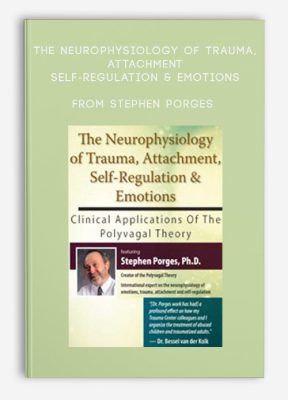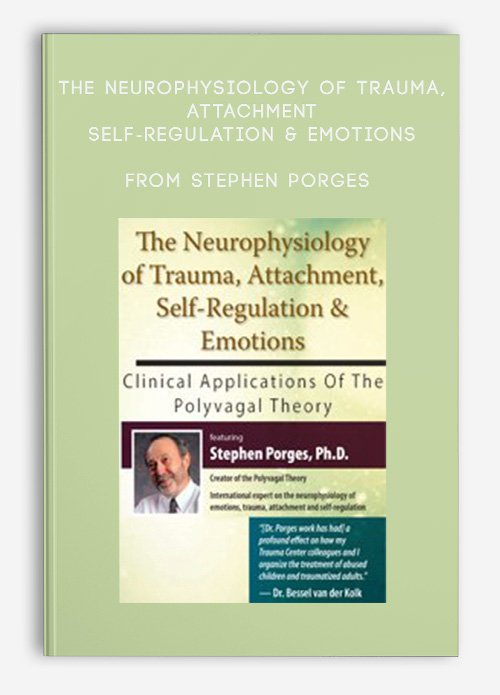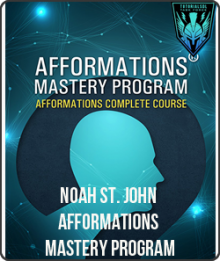The Neurophysiology of Trauma, Attachment, Self-Regulation & Emotions from Stephen Porges
$219.00 $65.00

The Neurophysiology of Trauma, Attachment, Self-Regulation & Emotions Clinical Applications of the Polyvagal Theory from Stephen Porges
Faculty:Stephen Porges
Duration:5 Hours 58 Minutes | Format:Audio and Video
Archive : The Neurophysiology of Trauma, Attachment, Self-Regulation & Emotions from Stephen Porges
Get The Neurophysiology of Trauma, Attachment, Self-Regulation & Emotions from Stephen Porges on Salaedu.com
Outline:
The Polyvagal Theory
- The principles and features of the Polyvagal Theory and how to apply it in a clinical setting
- How the Polyvagal Theory can demystify several features related to stress-related illnesses and psychiatric disorders such as PTSD, autism, depression, and anxiety
- How the Social Engagement System is compromised by stress and trauma and how to reset it
- Evolutionary changes and adaptive functions in the autonomic nervous system
- Humans response hierarchy to challenges
- Three neural platforms that provide the neurophysiological bases for social engagement, fight/flight, and shutdown behaviors
Social Engagement System and Psychiatric and Behavioral Disorders
- A description of the “face-heart” connection that forms a functional social engagement system
- How our facial expressions, vocalizations, and gestures are regulated by neural mechanisms that are involved in regulating our autonomic nervous system
Neuroception: Detecting and Evaluating Risk
- How our social and physical environment triggers changes in physiological state
- Understanding that adaptive physiological reactions may result in maladaptive behaviors
- Immobilization without fear
- Play as a neural exercise
- Listening as a neural exercise
Demystifying Biobehavioral Responses to Trauma and Abuse
- Fight/flight and immobilization defense strategies
- Adaptive function of immobilization and the associated clinical difficulties
- How the stresses and challenges of life distort social awareness and displace spontaneous social engagement behaviors with defensive reactions
Applying the Polyvagal Theory in Clinical Settings
- Understanding auditory hypersensitivities
- State regulation as a core feature of psychiatric disorders
- Deconstructing features of autism and PTSD
- Strategies to explain disruption and repair of symbiotic regulation
- Identifying social cues that disrupt or repair defensive reaction
Get The Neurophysiology of Trauma, Attachment, Self-Regulation & Emotions from Stephen Porges on Salaedu.com
Description:
- Are the trauma, attachment and self-regulation interventions you use based on an outdated understanding of the neurophysiology?
- Is your treatment model rooted in an understanding of client arousal based on traditional maeasures without incorporating concepts from the Polyvagal Theory?
- During therapy sessions, are you aware that you and your client are responding to each other’s physiological state?
- Are your interactions with your clients missing an understanding of how mental processes influence physiology and how physiology influences cognitive, emotional, and social behavior?
If you aren’t consciously monitoring your client’s facial features and vocal intonation, you could be missing important cues of the social engagement system and therapeutic opportunities.
Dr. Stephen Porges is an recognized professional on the neurophysiology of emotions, trauma, attachment and self regulation. He will show you how you can put this understanding to use when implementing interventions for mediating symptoms of many mental health disorders including autism, depression, ADD and PTSD. In addition, learn strategies to trigger states of safety in your clients by activating the “highest level” mechanism.
1 review for The Neurophysiology of Trauma, Attachment, Self-Regulation & Emotions from Stephen Porges
Add a review Cancel reply
Related products
HEALTH - FITNESS - LIFESTYLE - MEDICAL
HEALTH - FITNESS - LIFESTYLE - MEDICAL
HEALTH - FITNESS - LIFESTYLE - MEDICAL
HEALTH - FITNESS - LIFESTYLE - MEDICAL
HEALTH - FITNESS - LIFESTYLE - MEDICAL
HEALTH - FITNESS - LIFESTYLE - MEDICAL
HEALTH - FITNESS - LIFESTYLE - MEDICAL
HEALTH - FITNESS - LIFESTYLE - MEDICAL










king –
“Thank you very much Dr. Porges. Your work is priceless and I will continue to read and advance my understanding of your theory. All I have begun to understand will greatly improve my therapeutic work and has given me great insight regarding interaction with my clients. I am very energized as what I now know will initiate greater healing of individuals that come to me. How fun is that!!! Roxanne L Miller”